`go run golang.org/x/tools/gopls/internal/analysis/modernize/cmd/modernize@latest -fix -test ./...` executed. `go generate ./...` ran afterwards to keep generated.
jstream is a streaming JSON parser and value extraction library for Go.
Unlike most JSON parsers, jstream is document position- and depth-aware -- this enables the extraction of values at a specified depth, eliminating the overhead of allocating encompassing arrays or objects; e.g:
Using the below example document:

we can choose to extract and act only the objects within the top-level array:
f, _ := os.Open("input.json")
decoder := jstream.NewDecoder(f, 1) // extract JSON values at a depth level of 1
for mv := range decoder.Stream() {
fmt.Printf("%v\n ", mv.Value)
}
output:
map[desc:RGB colors:[red green blue]]
map[desc:CMYK colors:[cyan magenta yellow black]]
likewise, increasing depth level to 3 yields:
red
green
blue
cyan
magenta
yellow
black
optionally, kev:value pairs can be emitted as an individual struct:
decoder := jstream.NewDecoder(f, 2).EmitKV() // enable KV streaming at a depth level of 2
jstream.KV{desc RGB}
jstream.KV{colors [red green blue]}
jstream.KV{desc CMYK}
jstream.KV{colors [cyan magenta yellow black]}
Installing
go get github.com/bcicen/jstream
Commandline
jstream comes with a cli tool for quick viewing of parsed values from JSON input:
jstream -d 1 < input.json
{"colors":["red","green","blue"],"desc":"RGB"}
{"colors":["cyan","magenta","yellow","black"],"desc":"CMYK"}
detailed output with -v option:
cat input.json | jstream -v -d -1
depth start end type | value
2 018 023 string | "RGB"
3 041 046 string | "red"
3 048 055 string | "green"
3 057 063 string | "blue"
2 039 065 array | ["red","green","blue"]
1 004 069 object | {"colors":["red","green","blue"],"desc":"RGB"}
2 087 093 string | "CMYK"
3 111 117 string | "cyan"
3 119 128 string | "magenta"
3 130 138 string | "yellow"
3 140 147 string | "black"
2 109 149 array | ["cyan","magenta","yellow","black"]
1 073 153 object | {"colors":["cyan","magenta","yellow","black"],"desc":"CMYK"}
0 000 155 array | [{"colors":["red","green","blue"],"desc":"RGB"},{"colors":["cyan","magenta","yellow","black"],"desc":"CMYK"}]
Options
| Opt | Description |
|---|---|
| -d <n> | emit values at depth n. if n < 0, all values will be emitted |
| -kv | output inner key value pairs as newly formed objects |
| -v | output depth and offset details for each value |
| -h | display help dialog |
Benchmarks
Obligatory benchmarks performed on files with arrays of objects, where the decoded objects are to be extracted.
Two file sizes are used -- regular (1.6mb, 1000 objects) and large (128mb, 100000 objects)
| input size | lib | MB/s | Allocated |
|---|---|---|---|
| regular | standard | 97 | 3.6MB |
| regular | jstream | 175 | 2.1MB |
| large | standard | 92 | 305MB |
| large | jstream | 404 | 69MB |
In a real world scenario, including initialization and reader overhead from varying blob sizes, performance can be expected as below:

